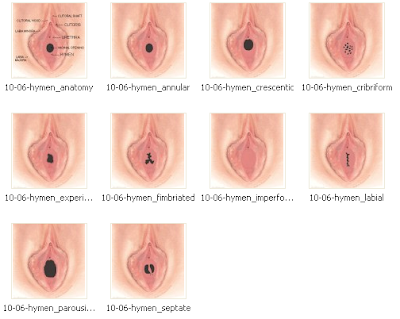HYMEN MEMEK PERAWAN REPAIR.BLOGSPOT.COM hp 087882172619 email : dr.anwar2008@gmail.com
Senin, 28 April 2008
Berapa biaya Operasi diluar negeri????
Bentuk Hymen
Apa keuntungan dari Hymenorraphy?
Such procedures are not generally regarded as part of mainstream gynecology, but are available from some plastic surgery centres, particularly in the USA, Japan and Western Europe, generally as day surgery. The normal aim is to cause bleeding during post-nuptial intercourse, which in some cultures is a required proof of virginity.
Varieties of the operation
The term may cover at least four significantly different types of procedure:
1. Suturing of a tear in the hymen such as might be caused by sexual assault, soon after the assault, to facilitate healing.
2. Use of a flap of the vaginal lining, complete with its blood supply, to create a new hymen. Patients are advised to refrain from penetrative sex for up to three months following these procedures.
Availability and legality
Some hymen reconstruction operations are legal in some countries, while other countries ban all hymenorrhaphy. Infibulation is in general illegal.
In the United States of America, hymen restoration is available in private clinics and becoming slightly more common.
Apakah itu hymen?
The hymen has no known anatomical function. In societies which value chastity, the greatest significance of the hymen is a traditional belief that an intact hymen indicates a state of intact virginity. However, it is not possible to confirm that a woman or post-pubescent girl is not a virgin by examining the hymen.[8] A physician routinely checks the appearance of the hymen of baby girls at birth[citation needed], and again during all future pelvic examinations. In cases of suspected rape or sexual abuse a detailed examination of the hymen may be carried out, however the condition of the hymen alone is often inconclusive or open to misinterpretation, especially if the patient has reached puberty.[9]
Most common forms of the hymen:
crescent-shaped, crescentic, or posterior rim: no hymenal tissue at the 12 o'clock position; narrow band of tissue starts at 1 or 2 o'clock going clockwise, is at its widest around 6 o'clock, and tapers off at 10 or 11 o'clock
annular, or circumferential: the hymen forms a ring around the vaginal opening; especially common in newborns[14]
redundant; sometimes sleeve-like: folds in on itself, which sometimes causes it to protrude; most common in infancy and at/following puberty due to estrogen levels;[15] can be combined with other type such as "annular and redundant"
Less common forms:
fimbriated or denticular: an irregular edge to the hymenal orifice; more likely at an age when estrogen is present
septate: the hymen has one or more bands extending across the opening
cribriform, or microperforate: the hymen stretches completely across the vaginal opening, but is perforated with several holes
labial, or vertical: hymen has an opening from the 12 to the 6 o'clock positions and can look similar to a third set of vulvar lips
imperforate:[16] hymen completely covers vaginal orifice; will require minor surgery if it has not corrected itself by puberty to allow menstrual fluids to escape
The hymen is torn or stretched by penetrative sex, and more so when a woman gives birth vaginally.
parous introitus refers to the vaginal opening which has had a baby pass through it and consequently has nothing left of its hymen but a fleshy irregular outline decorating its perimeter; these tags are called carunculae mytriformes
What might damage the hymen
The hymen may be damaged by playing sports, using tampons, pelvic examinations or even straddle injuries.[21]
Once a girl reaches puberty, the hymen tends to become quite elastic. It is not possible to determine whether a woman uses tampons or not by examining her hymen. Sexual intercourse is one of the most common ways to damage the hymen, although in one survey only 43% of women reported bleeding the first time they had sex; which means that in the other 57% of women the hymen likely stretched enough that it didn't tear.[21]
It is rare to damage the hymen through accidental injury, such as falling on the top tube of a bicycle. Although such an accident may cause bleeding, this is usually due to damage to surrounding tissues such as the labia.[22] It is unlikely that an accident would damage the hymen without injuring any other part of the vulva. Therefore, damage to the hymen alone, described as an accident, would be seen as a strong indicator of sexual assault.
